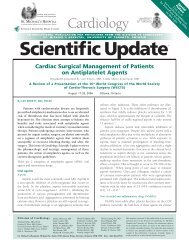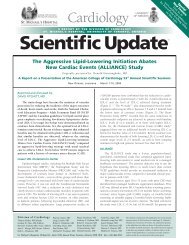Novel Insights into the Renin Cascade and Heart Disease
Novel Insights into the Renin Cascade and Heart Disease
Novel Insights into the Renin Cascade and Heart Disease
You also want an ePaper? Increase the reach of your titles
YUMPU automatically turns print PDFs into web optimized ePapers that Google loves.
Figure 1: ACE inhibitor <strong>and</strong> myocardial infarction<br />
mortality trials<br />
Broad (short-term)<br />
Total = 96,635 patients<br />
CONSENSUS II<br />
GISSI-3<br />
ISIS-4<br />
Chinese-Captopril<br />
5 lives saved/1000<br />
over 6 weeks<br />
Selective<br />
(higher risk, long-term)<br />
Total = 7,522 patients<br />
SAVE (EF ≤40%)<br />
AIRE (clinical heart failure)<br />
TRACE (wall motion score,<br />
EF ≤35%)<br />
SMILE (anterior MI, no lytic)<br />
60 lives saved/1000<br />
over 3 years<br />
MI (Figure 1). 8,13 The greatest relative <strong>and</strong> absolute benefits,<br />
however, were observed in trials that selected patients at<br />
higher risk, based on evidence of LV dysfunction or <strong>the</strong><br />
presence of heart failure. 14 In studies such as SAVE, AIRE<br />
(Acute Infarction Ramipril Efficacy), <strong>and</strong> TRACE (Tr<strong>and</strong>olapril<br />
Cardiac Evaluation), <strong>the</strong> odds ratio for ACE-inhibitor attributed<br />
reduction in all-cause mortality was 0.74% (95% confidence<br />
interval [CI], 0.66%-0.83%), with comparable benefits<br />
achieved when major, nonfatal cardiovascular events (eg,<br />
hospitalization for heart failure 0.73%, 99.5% CI, 0.63%-<br />
0.85%; <strong>and</strong> recurrent MI 0.80%, 99% CI, 0.69%-0.94%)<br />
were evaluated (Figure 2). 6,8,15,16<br />
ARBs provide an alternative approach for blocking <strong>the</strong><br />
RAAS, 17 potentially providing a more complete blockade of<br />
<strong>the</strong> actions of angiotensin II, but without <strong>the</strong> <strong>the</strong>oretically<br />
beneficial bradykinin-preserving effect of ACE inhibition. 18,19<br />
The Optimal Trial in Myocardial Infarction with <strong>the</strong><br />
Angiotensin II Antagonist Losartan (OPTIMAAL) was <strong>the</strong><br />
first attempt to compare an ARB with an ACE inhibitor in<br />
patients following MI. 20 In OPTIMAAL, <strong>the</strong> ARB, losartan, at<br />
a dose of 50 mg/day, was compared with <strong>the</strong> ACE inhibitor,<br />
captopril, 150 mg/day, in high-risk patients with acute MI.<br />
There was a strong trend in favour of captopril in <strong>the</strong> primary<br />
endpoint of total mortality (p= 0.07). A similar trend in<br />
favour of <strong>the</strong> same dose of captopril over <strong>the</strong> same dose of<br />
losartan was observed in patients with chronic heart failure in<br />
<strong>the</strong> Evaluation of Losartan in <strong>the</strong> Elderly II (ELITE-II) trial. 21<br />
The Valsartan in Acute Myocardial Infarction (VALIANT)<br />
trial compared <strong>the</strong> effects of <strong>the</strong> ARB, valsartan, <strong>the</strong> ACE<br />
inhibitor, captopril, <strong>and</strong> <strong>the</strong> combination of valsartan <strong>and</strong><br />
captopril in a population of high-risk patients with clinical or<br />
radiologic evidence of heart failure, evidence of LV systolic<br />
dysfunction, or both, after acute MI. 22 A total of 14,808<br />
patients underwent r<strong>and</strong>omization in a 1:1:1 ratio to receive<br />
valsartan (titrated to 160 mg twice daily), captopril (titrated<br />
to 50 mg 3 times daily), or <strong>the</strong> combination of valsartan<br />
(titrated to 80 mg twice daily) <strong>and</strong> captopril (titrated to<br />
50 mg 3 times daily), beginning 12 hours to 10 days after an<br />
MI. The primary endpoint of <strong>the</strong> study was death from any<br />
cause. Importantly, a pre-specified analysis was designed to<br />
demonstrate <strong>the</strong> noninferiority or equivalence of valsartan to<br />
captopril, in <strong>the</strong> event that valsartan was not clearly shown<br />
to be superior in <strong>the</strong> primary analysis.<br />
During a median follow-up of 24.7 months, mortality<br />
was 19.9% in <strong>the</strong> valsartan group, 19.5% in <strong>the</strong> captopril<br />
group, <strong>and</strong> 19.3% in <strong>the</strong> valsartan-<strong>and</strong>-captopril group<br />
(Figure 3). The hazard ratio for death in <strong>the</strong> valsartan group,<br />
as compared with <strong>the</strong> captopril group, was 1.00 (97.5% CI,<br />
0.90 to 1.11; P=0.98), <strong>and</strong> <strong>the</strong> hazard ratio for death in <strong>the</strong><br />
valsartan-<strong>and</strong>-captopril group, as compared with <strong>the</strong> captopril<br />
group, was 0.98 (97.5% CI, 0.89 to 1.09; P=0.73). The<br />
number of patients reaching target dose after 1 year was 56%<br />
Figure 2: All-cause mortality in <strong>the</strong> SAVE, AIRE, <strong>and</strong><br />
TRACE studies<br />
Probability of event<br />
0.4<br />
0.35<br />
0.3<br />
0.25<br />
0.2<br />
0.15<br />
0.1<br />
0.05<br />
Placebo<br />
ACEI<br />
Placebo: 866/2971 (29.1%)<br />
ACEI: 702/2995 (23.4%)<br />
Odds ratio: 0.74 (0.66-0.83)<br />
0<br />
Years 0 1 2 3 4<br />
ACEI 2995 2250 1617 892 223<br />
Placebo 2971 2184 1521 853 138<br />
Figure 3: All-cause mortality in VALIANT<br />
Probability of event<br />
0.3<br />
0.25<br />
0.2<br />
0.15<br />
0.1<br />
Captopril<br />
Valsartan<br />
Valsartan + Captopril<br />
0.05<br />
Valsartan vs. Captopril: HR = 1.00; P = 0.982<br />
Valsartan + Captopril vs. Captopril: HR = 0.98; P = 0.726<br />
0<br />
Months 0 6 12 18 24 30 36<br />
Captopril 4909 4428 4241 4018 2635 1432 364<br />
Valsartan 4909 4464 4272 4007 2648 1437 357<br />
Valsartan + Cap 4885 4414 4265 3994 2648 1435 382<br />
Cardiology<br />
Scientific Update




